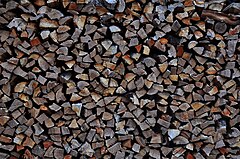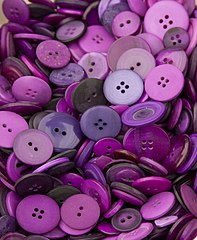Nonstandard color words
| Part of a series on |
| kule |
Core tones
|
| Nonstandard color words |
Toki Pona speakers have coined several nonstandard color words.
kapesi
 | |
| Pronunciation | /ˈka |
|---|---|
| Usage | 2023: Obscure4, Rare6 (19% ↗︎ ) |
| Book and era | nimi ku lili (pre-pu) |
| Part of speech | Content word |
kapesi is an obscure, pre-pu nimi ku lili for brown and gray.[1] It is derived from either Cantonese 咖啡色 (gaa3 fe1 sik1) or Mandarin 咖啡色 (kāfēisè), meaning "brown" (literally, "coffee color").
In practice, it is more commonly used for browns than grays, because browns are usually hard to describe with pu words, while grays can easily be described as pimeja walo ("light black") or walo pimeja ("dark white").
unu
 | |
| Pronunciation | /ˈu |
|---|---|
| Usage | 2023: Obscure4, Rare6 (16% ↗︎ ) |
| Book and era | nimi ku lili (post-pu) |
| Part of speech | Content word |
unu is a an obscure, post-pu nimi ku lili for purple and purple–adjacent colors, including violets, and sometimes magentas and indigos.[2] It was coined by jan Sonja in 2020 and is derived from Indonesian ungu.[3]
nalanja
| Pronunciation | /ˈna |
|---|---|
| Usage | 2023: Obscure (3% ↗︎ ) |
| Book and era | No book (post-ku) |
| Part of speech | Content word |
nalanja is an obscure word and nimi sin for orange and similar colors. It was derived from Spanish naranja, meaning "orange". Similar words include analanjato, jole, and lejo.
There are several sitelen pona glyph for nalanja. The main glyph (nalanja), as shown in the available fonts by jan Lepeka, is composed of glyph for kili above the color triangle radical. Other variations include the following glyphs:
-
Glyph with semicircle above color radical, used in sitelen seli kiwen until December 2023
-
Glyph as combination of loje and jelo, proposed by tonsi Losi
-
Glyph with seli above color radical
-
Glyph with emitters above color radical, proposed by ma Seli
-
Glyph with an apple above color radical, drawn by kili Pami
-
Glyph with two circles divided into sections
In an article for lipu tenpo nanpa sewi, kapesi Pake advocated for the glyph composed of glyph for kili and the color radical.
peta
| Pronunciation | /ˈpe |
|---|---|
| Usage | 2023: Obscure (2% ↗︎ ) |
| Book and era | No book (post-pu) |
| Part of speech | Content word |
peta is an obscure word intended for green and green–adjacent colors, as well as meanings related to verdancy, liveliness, and eco-friendliness.[4] It was coined by kili Tesa in 2019, and is derived from Esperanto verda, meaning "green".
References
- ↑ Lang, Sonja. (18 July 2021). Toki Pona Dictionary. Illustrated by Vacon Sartirani. Tawhid. ISBN 978-0978292362. p. 242.
- ↑ Lang, Sonja. (18 July 2021). Toki Pona Dictionary. Illustrated by Vacon Sartirani. Tawhid. ISBN 978-0978292362. p. 382.
- ↑ jan Sonja [@sonjalang]. (23 December 2020). [Message posted in the
#toki-ponachannel in the ma pona pi toki pona Discord server]. Discord. "ken la nimi sin li unu tan nimi ungu pi toki Intonesija". - ↑ kili Tesa [@jezzzzzzzzzz]. (9 November 2019). [Message posted in the
#pana-sonachannel in the ma pona pi toki pona Discord server]. Discord.





